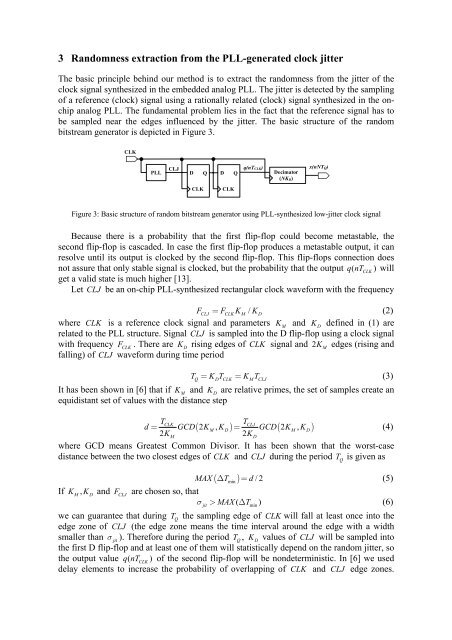SIMPLE PLL-BASED TRUE RANDOM NUMBER ... - KEMT FEI TUKE
SIMPLE PLL-BASED TRUE RANDOM NUMBER ... - KEMT FEI TUKE
SIMPLE PLL-BASED TRUE RANDOM NUMBER ... - KEMT FEI TUKE
Create successful ePaper yourself
Turn your PDF publications into a flip-book with our unique Google optimized e-Paper software.
3 Randomness extraction from the <strong>PLL</strong>-generated clock jitter<br />
The basic principle behind our method is to extract the randomness from the jitter of the<br />
clock signal synthesized in the embedded analog <strong>PLL</strong>. The jitter is detected by the sampling<br />
of a reference (clock) signal using a rationally related (clock) signal synthesized in the onchip<br />
analog <strong>PLL</strong>. The fundamental problem lies in the fact that the reference signal has to<br />
be sampled near the edges influenced by the jitter. The basic structure of the random<br />
bitstream generator is depicted in Figure 3.<br />
CLK<br />
CLJ<br />
<strong>PLL</strong> D<br />
CLK<br />
Q<br />
D<br />
CLK<br />
Q<br />
q(nTCLK)<br />
Decimator<br />
(NKD)<br />
x(nNTQ)<br />
Figure 3: Basic structure of random bitstream generator using <strong>PLL</strong>-synthesized low-jitter clock signal<br />
Because there is a probability that the first flip-flop could become metastable, the<br />
second flip-flop is cascaded. In case the first flip-flop produces a metastable output, it can<br />
resolve until its output is clocked by the second flip-flop. This flip-flops connection does<br />
not assure that only stable signal is clocked, but the probability that the output qn ( T CLK ) will<br />
get a valid state is much higher [13].<br />
Let CLJ be an on-chip <strong>PLL</strong>-synthesized rectangular clock waveform with the frequency<br />
FCLJ = FCLK KM/ KD<br />
(2)<br />
where CLK is a reference clock signal and parameters K M and KD<br />
defined in (1) are<br />
related to the <strong>PLL</strong> structure. Signal CLJ is sampled into the D flip-flop using a clock signal<br />
with frequency F CLK . There are KD rising edges of CLK signal and 2K M edges (rising and<br />
falling) of CLJ waveform during time period<br />
TQ = KDTCLK = KMTCLJ (3)<br />
It has been shown in [6] that if K M and KD<br />
are relative primes, the set of samples create an<br />
equidistant set of values with the distance step<br />
TCLK TCLJ<br />
d = GCD( 2 KM, KD) = GCD( 2 KM,<br />
K D)<br />
(4)<br />
2KM 2KD<br />
where GCD means Greatest Common Divisor. It has been shown that the worst-case<br />
distance between the two closest edges of CLK and CLJ during the period T Q is given as<br />
( )<br />
If KM, K D and F CLJ are chosen so, that<br />
σ > MAX ( ∆ T )<br />
MAX ∆ T = d /2<br />
(5)<br />
jit<br />
we can guarantee that during T Q the sampling edge of CLK will fall at least once into the<br />
edge zone of CLJ (the edge zone means the time interval around the edge with a width<br />
smaller than σ jit ). Therefore during the period T Q , D values of CLJ will be sampled into<br />
the first D flip-flop and at least one of them will statistically depend on the random jitter, so<br />
the output value of the second flip-flop will be nondeterministic. In [6] we used<br />
delay elements to increase the probability of overlapping of and CLJ edge zones.<br />
K<br />
qnT ( CLK )<br />
CLK<br />
min<br />
min<br />
(6)








